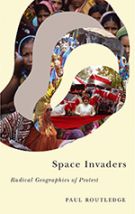Space Invaders: Radical Geographies of Protest

Space Invaders departs from the premise that “there is a geographical logic to all forms of protest” (page 1). To understand a range of recent protest movements, it uses a radical geography lens. This has two main branches of analysis: spatial strategies and sites of intervention. Spatial strategies include “make some space,” where protestors shape physical spaces, such as by occupying Tahrir Square in Cairo (during the 2011 Arab Spring) or occupying urban neighbourhoods in Athens (to protest austerity measures in 2013). These spaces can also be media-based rather than physical. The spatial strategy that author Paul Routledge labels “wage wars of words” involves transmitting alternative narratives, for instance through the posters and testimonials of the anti-dam Save the Narmada Movement in Maharashtra, India.
The other spatial strategies Routledge outlines are “know your place,” “stay mobile,” extend your reach,” and “feel out of place.” One chapter is devoted to each of the five spatial strategies. These connect activist movements that might otherwise seem distant in both aims and locations, but in this analysis share a set of activist tools and methods.
Routledge’s classification system also includes at least nine types of intervention sites. These are:
1) Sites of production (e.g. the unionist movement in the port of Gdansk, Poland)
2) Sites of destruction (e.g. Palestinians’ continued occupancy of homes planned for destruction or takeover by Israeli settlers)
3) Sites of decision (e.g. Zapatistas’ guerrilla attacks on Mexican town halls and police stations as part of resistance to the North American Free Trade Agreement)
4) Sites of social reproduction (e.g. the “worker-recuperated workplaces” in Argentina that have come to include bakeries, clinics and schools)
5) Sites of circulation (e.g. the road closures by the pro-pedestrian Reclaim the Streets group in the UK)
6) Sites of consumption (e.g. the Black Lives Matter protest at the Mall of America Minneapolis, intended partly to challenge racial profiling in shopping centres)
7) Sites of potential (e.g. the Bangladeshi farmers groups BKF and BKS occupying areas affected by climate change including swampland and salt-soaked land)
8) Sites of assumption (e.g. the Movement for the Restoration of Democracy protesting monarchist symbols in Nepal)
9) Sites of collaboration (e.g. grassroots food sovereignty movements that have connected peasant groups in 15 countries)
An emerging 10th site might be “sites of information”, encompassing hacker networks and anti-surveillance protestors.
Routledge (who bears the intriguing title Professor of Contentious Politics and Social Change at the University of Leeds) is writing within a tradition of activist geography, with clear sympathies for the protestors he studies. In developing a geography-focused framework for analysing these social mobilizations, he stresses (page 149) that “In fashioning radical futures a keen sense of geography will be critical. We will need to think spatially and strategically.”
Further reading:
Fahmi, Wael Salah (2009), “Bloggers’ street movement and the right to the city: (Re)claiming Cairo’s real and virtual “spaces of freedom””, Environment and Urbanization Vol 21, No 1, pages 89–107, available at http://journals.sagepub.com/doi/pdf/10.1177/0956247809103006.
Kamete, Amin Y (2009), “For enhanced civic participation in local governance”: calling tyranny to account in Harare”, Environment and Urbanization Vol 21, No 1, pages 59–75, available at http://journals.sagepub.com/doi/pdf/10.1177/0956247809103004.
Nganyanyuka, Kapongola, Javier Martinez, Juma Lungo and Yola Georgiadou (2018), “If citizens protest, do water providers listen? Water woes in a Tanzanian town”, Environment and Urbanization Vol 30, No 2, available at http://journals.sagepub.com/doi/abs/10.1177/0956247817744942.
Book note prepared by Christine Ro
Search the Book notes database
Our Book notes database contains details and summaries of all the publications included in Book notes since 1993 - with details on how to obtain/download.
Use the search form above, or visit the Book notes landing page for more options and latest content.
For a searchable database for papers in Environment and Urbanization, go to http://eau.sagepub.com/

